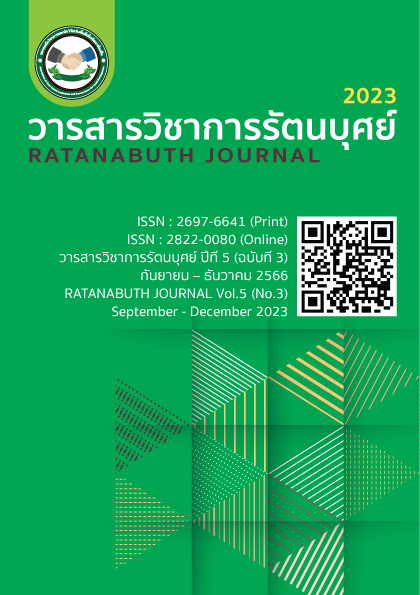Development of Components and Indicators for Deciding on the Selection of Provincial Administrative Organization Members. Of the People in the Northeastern Region Development of Components and Indicators for Deciding on the Selection of Provincial Administrative Organization Members. Of the People in the Northeastern Region
Main Article Content
Abstract
This study was to investigate survey elements and indicators. Deciding on the selection of Provincial Administrative Organization members by the people To create and examine a model of elements and indicators for people's selection of Provincial Administrative Organization members. and to confirm the consistency and harmony of the model. Composition and indicators Deciding on the selection of Provincial Administrative Organization members by the people in the central northeastern region The population and sample were 400 people using a simple random sampling method. The obtained statistics included exploratory factor analysis statistics and confirmatory factor analysis statistics. The results of the study found that 1) Components and indicators surveying the decision to select Provincial Administrative Organization members found 7 elements and 56 indicators, including characteristics of candidates. Group or political party Element weight range In terms of campaigning methods for election candidates Element weight range elements that In terms of campaign media and media of people who influence decision-making elements that Personal relationship with the applicant elements that The exchange of benefits elements that Policy aspects of the candidates 2) Affirmative elements Model for measuring the decision to select Provincial Administrative Organization members. The index values used to check the validity of the model were = 12685.21, df = 1477,
/df = 8.588, p - Value = 0.06, CFI = 0.90, GFI = 0.56, AGFI = 0.52, RMSEA= 0.11, SRMR = 0.18 3) Creating and confirming the measurement model was found to be Deciding on the selection of Provincial Administrative Organization members Experts attach great importance to the use of new media, especially determining important content about the characteristics of election candidates to present through online social networking media. which influences people's decision to select Provincial Administrative Organization members.
Article Details

This work is licensed under a Creative Commons Attribution-NonCommercial-NoDerivatives 4.0 International License.
References
กานต์ บุญศิริ (2565). การจัดการการสื่อสารผลการดำเนินงานตามนโยบายและยุทธศาสตร์ ขององค์การบริหารส่วนจังหวัดสงขลา. วารสารวิจัยและพัฒนา มหาวิทยาลัยราชภัฏสวนสุนันทา,14(2). 192-206.
โกวิทย์ พวงงาม. (2563). คูมือเลือกตั้งทองถิ่น. กรุงเทพฯ : มูลนิธิคอนราด อาเดนาวร์.
พระปัญญาฤทธิ์ สิริวฑฺฒโก และคณะ. (2566). ปัจจัยที่มีผลต่อการตัดสินใจเลือกตั้งสมาชิกสภาผู้แทนราษฎรของประชาชน ในอำเภอเลิงนกทา จังหวัดยโสธร. วารสาร มจร สังคมศาสตร์ปริทรรศน์, 12(3), 331-342.
ภัทรวดี อภิเด่นนภาลัย. (2562). การสื่อสารทางการเมือง ค่านิยม ผลประโยชน์ และระบอบการเมืองที่ส่งผลการตัดสินใจเลือกของประชาชนให้นักการเมืองได้รับเลือกตั้ง พื้นที่จังหวัดสมุทรปราการ เขต 2. วารสารสันติศึกษาปริทรรศน์ มจร, 7(5). 1352-1362.
วุฒิสาร ตันไชย. (2557). การกระจายอำนาจและประชาธิปไตยในประเทศไทย. กรุงเทพฯ: สถาบันพระปกเกล้า.
สัญญา สัญญาวิวัฒน์. (2551). ทฤษฎีสังคมวิทยา: เนื้อหาและแนวการใช้ประโยชน์เบื้องต้น. พิมพ์ครั้งที่ 13 กรุงเทพฯ : จุฬาลงกรณ์มหาวิทยาลัย.
สุจิต บุญบงการ. (2547). การมีส่วนร่วมทางการเมืองกับพัฒนาการทางการเมือง. นทบุรี: มหาวิทยาลัยสุโขทัยธรรมาธิราช.
Berlo, David K. 1960. The Process of Communication. New York : Holt, Rinehart and Winston. Mc Croskey.
Delli Carpini, Michael X., Lawrence R. Hamilton, and Scott Keeter. (2014). The Impact of Social Media on Political Participation: Evidence from the United States. Journal of Politics 76(3), 729-748.
Lau, R. P., Pomper, G. M., & Plutzer, M. J. (2006). The role of candidate traits in electoral outcomes. In R. P. Lau & D. Redlawsk (Eds.), Media effects and political decision making. Lawrence, KS: University Press of Kansas.
Mackie, M. B., & Delli Carpini, M. M. (2013). The Impact of Social Media on Political Decision-Making. The Annals of the American Academy of Political and Social Science, 647(1), 214-232.
Xenos, M. A., Newby, A., & Wall, D. C. (2014). The impact of social media on political decision-making. Journal of Communication, 64(2), 296-319.


